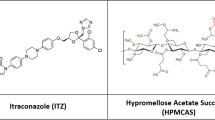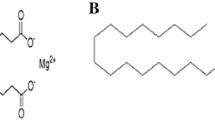Abstract
The addition of surfactant in tablet was a well-defined approach to improve drug dissolution rate. While the selected surfactant played a vital role in improving the wettability of tablet by medium, it was equally important to improve the dissolution rate by permeation effect due to production of pores or the reduced inter-particle adhesion. Furthermore, understanding the mechanism of dissolution rate increased was significant. In this work, contact angle measurement was taken up as an alternative approach for understanding the dissolution rate enhancement for tablet containing surfactant. Ethylcellulose, as a substrate, was used to prepare tablet. Four surfactants, sodium dodecyl sulfate (SDS), sodium dodecylbenzenesulfonate (SDBS), dodecyltrimethylammonium bromide (DTAB), and sodium lauryl sulfonate (SLS), were used. Berberine hydrochloride, metformin hydrochloride, and rutin were selected as model drugs. The contact angle of tablet in the absence and presence of surfactant was measured to explore the mechanism. The dissolution test was investigated to verify the mechanism and to establish a correlation with the contact angle. The result showed that the mechanism was the penetration effect rather than the wetting effect. The dissolution increased with a reduction in the contact angle. DTAB was found to obtain the highest level of dissolution enhancement and the lowest contact angle, while SDS, SDBS, and SLS were found to be the less effective in both dissolution enhancement and contact angle decrease. Therefore, contact angle was a good indicator for dissolution behavior besides exploring the mechanism of increased dissolution, which shows great potential in formula screening.






Similar content being viewed by others
References
Hörter D, Dressman JB. Influence of physicochemical properties on dissolution of drugs in the gastrointestinal tract. Adv Drug Deliv Rev. 2001;46:75–87.
Eldin SMB, Elkheshen SA, Ghorab MM. Improving tadalafil dissolution via surfactant-enriched tablets approach: statistical optimization, characterization, and pharmacokinetic assessment. J Drug Deliv Sci Tech. 2017;41:197–205.
Serajuddin AT. Salt formation to improve drug solubility. Adv Drug Deliv Rev. 2007;59(7):603–16.
Jung MS, Kim JS, Kim MS, Alhalaweh A, Cho W, Hwang SJ, et al. Bioavailability of indomethacin-saccharin cocrystals. J Pharm Pharmacol. 2010;62(11):1560–8.
Jain S, Patel N, Lin S. Solubility and dissolution enhancement strategies: current understanding and recent trends. Drug Dev Ind Pharm. 2015;41(6):875–87.
Tatavarti AS, Hoag SW. Microenvironmental pH modulation based release enhancement of a weakly basic drug from hydrophilic matrices. J Pharm Sci. 2006;95(7):1459–68.
Matsui R, Ueda O, Uchida S, Namiki N. Transdermal absorption of natural progesterone from alcoholic gel formulations with hydrophilic surfactant. Drug Dev Ind Pharm. 2015;41(6):1026–9.
Wong SM, Kellaway IW, Murdan S. Enhancement of the dissolution rate and oral absorption of a poorly water soluble drug by formation of surfactant-containing microparticles. Int J Pharm. 2006;317(1):61–8.
Ng CL, Lee S-E, Lee J-K, Kim T-H, Jang WS, Choi J-S, et al. Solubilization and formulation of chrysosplenol C in solid dispersion with hydrophilic carriers. Int J Pharm. 2016;512(1):314–21.
Okonogi S, Puttipipatkhachorn S. Dissolution improvement of high drug-loaded solid dispersion. AAPS PharmSciTech. 2006;7:E52.
Basalious EB, Sebaie WE, Gazayerly OE. Application of pharmaceutical QbD for enhancement of the solubility and dissolution of a class II BCS drug using polymeric surfactants and crystallization inhibitors: development of controlled-release tablets. AAPS PharmSciTech. 2011;12(3):799–810.
Sakeer K, Zein HA, Hassan I, Desai S, Nokhodchi A. Enhancement of dissolution of nystatin from buccoadhesive tablets containing various surfactants and a solid dispersion formulation. Arch Pharm Res. 2010;33(11):1771–9.
Park SH, Choi HK. The effects of surfactants on the dissolution profiles of poorly water-soluble acidic drugs. Int J Pharm. 2006;321(1–2):35–41.
Jamzad S, Fassihi R. Role of surfactant and pH on dissolution properties of fenofibrate and glipizide—a technical note. AAPS PharmSciTech. 2006;7:E17–22.
Hurwitz G, Guillen GR, Hoek EMV. Probing polyamide membrane surface charge, zeta potential, wettability, and hydrophilicity with contact angle measurements. J Membr Sci. 2010;349(1–2):349–57.
Bajaj A, Rao MR, Pardeshi A, Sali D. Nanocrystallization by evaporative antisolvent technique for solubility and bioavailability enhancement of telmisartan. AAPS PharmSciTech. 2012;13(4):1331–40.
Tolia G, Li SK. Silicone adhesive matrix of verapamil hydrochloride to provide pH-independent sustained release. AAPS PharmSciTech. 2014;15(1):1–10.
Chow KT, Chan LW, Heng PW. Characterization of spreadability of nonaqueous ethylcellulose gel matrices using dynamic contact angle. J Pharm Sci. 2008;97(8):3467–82.
Riedl Z, Szklenárik G, Zelkó R, Marton S, Rácz I. The effect of temperature and polymer concentration on dynamic surface tension and wetting ability of hydroxypropylmethylcellulose solutions. Drug Dev Ind Pharm. 2000;26:1321–3.
Peh KK, Wong CF, Yuen KH. Possible mechanism for drug retardation from glyceryl monostearate matrix system. Drug Dev Ind Pharm. 2000;26(4):447–50.
Verma S, Rudraraju VS. Wetting kinetics: an alternative approach towards understanding the enhanced dissolution rate for amorphous solid dispersion of a poorly soluble drug. AAPS PharmSciTech. 2015;16(5):1079–90.
Dahlberg C, Fureby AM, Schuleit M. Surface composition and contact angle relationships for differently prepared solid dispersions. Eur J Pharm Biopharm. 2008;70(2):478–85.
Lu Y, Tang N, Lian R, Qi J, Wu W. Understanding the relationship between wettability and dissolution of solid dispersion. Int J Pharm. 2014;465:25–31.
Heng JYY, Bismarck A, Williams DR. Anisotropic surface chemistry of crystalline pharmaceutical solids. AAPS PharmSciTech. 2006;7:E12–20.
Owens DK, Wendt RC. Estimation of the surface free energy of polymers. J Appl Polym Sci. 1969;13:1741–7.
Islam MS, Tong L, Falzon PJ. Influence of metal surface preparation on its surface profile, contact angle, surface energy and adhesion with glass fibre prepreg. Int J Adhes Adhes. 2014;51:32–41.
Costa P, JMS L. Modeling and comparison of dissolution profiles. Eur J Pharm Sci. 2001;13:123–33.
Balakrishnan A, Rege BD, Amidon GL, Polli JE. Surfactant-mediated dissolution: contributions of solubility enhancement and relatively low micelle diffusivity. J Pharm Sci. 2004;93(8):2064–75.
Granero GE, Ramachandran C, Amidon GL. Dissolution and solubility behavior of fenofibrate in sodium lauryl sulfate solutions. Drug Dev Ind Pharm. 2005;31(9):917–22.
Efentakis M, Hmoud HA, Buckton G, Rajan Z. The influence of surfactants on drug release from a hydrophobic matrix. Int J Pharm. 1991;70:153–8.
Li X, Banham D, Feng F, Forouzandeh F, Ye S, Kwok DY, et al. Wettability of colloid-imprinted carbons by contact angle kinetics and water vapor sorption measurements. Carbon. 2015;87:44–60.
Buckton G, Efentakis M, Hmoud HA, Rajan Z. The influence of surfactants on drug release from acrylic matrices. Int J Pharm. 1991;74:169–74.
Koennings S, Berie A, Tessmar J, Blunk T, Goepferich A. Influence of wettability and surface activity on release behavior of hydrophilic substances from lipid matrices. J Control Release. 2007;119(2):173–81.
Heng PWS, Wan LSC. Surfactant effect on the dissolution of sulfanilamide granules. J Pharm Sci. 1985;74:269–72.
Svitova T, Hill RM, Radke CJ. Adsorption layer structures and spreading behavior of aqueous non-ionic surfactants on graphite. Colloids Surf A. 2001;183:607–20.
Alhmoud HA, Ibrahim NE, El-Hallous EI. Surfactants solubility, concentration and the other formulations effects on the drug release rate from a controlled-release matrix. Afr J Pharm Pharmacol. 2014;8(13):364.
Wells ML, Parrott EL. Models for release of chlorpheniramine and a noninteracting compound from an inert, heterogeneous matrix containing an anionic surfactant. Drug Dev Ind Pharm. 1992;18:265–84.
Desai D, Wong B, Huang Y, Ye Q, Guo H, Huang M, et al. Wetting effects versus ion pairs diffusivity: interactions of anionic surfactants with highly soluble cationic drugs and its impact on tablet dissolution. J Pharm Sci. 2015;104(7):2255–65.
Shi SQ, Gardner DJ. Dynamic adhesive wettability of wood. Wood Fiber Sci. 2001;33:58–68.
Bolourtchian N, Javid FS, Dadashzadeh S. The effect of various surfactants on release behavior of procainamide HCl from ethylcellulose based matrices. Iran J Pharm Res. 2005;4:13–9.
Nokhodchi A, Hassan-Zadeh D, Monajjem-Zadeh F, Taghi-Zadeh N. Effect of various surfactants and their concentration on controlled release of captopril from polymeric matrices. Acta Pharma. 2008;58:151.
Feely LC, Davis SS. Influence of surfactants on drug release from hydroxypropylmethylcellulose matrices. Int J Pharm. 1988;41(1):83–90.
Nokhodchi A, Norouzi-Sani S, Siahi-Shadbad MR, Lotfipoor F, Saeedi M. The effect of various surfactants on the release rate of propranolol hydrochloride from hydroxypropylmethylcellulose (HPMC)-Eudragit matrices. Eur J Pharm Sci. 2002;54:349.
Shah SK, Chatterjee SK, Bhattarai A. The effect of methanol on the micellar properties of dodecyltrimethylammonium bromide (DTAB) in aqueous medium at different temperatures. J Surfactant Deterg. 2015;19(1):201–7.
Bakshi MS, Kaur N, Mahajan RK. A comparative behavior of photophysical properties of Pluronic F127 and Triton X-100 with conventional zwitterionic and anionic surfactants. J Photoch Photobio A. 2006;183(1–2):146–53.
Veiga MD, Ahsan F. Influence of surfactants over the dissolution of mequitazine. Drug Dev Ind Pharm. 2008;23:717–9.
Razvi N, Siddiqui SA, Khan LG. The effect of surfactant on the dissolution rate of ibuprofen tablets. Intl Chern Pharm Med J. 2005:213–6.
Kalin M, Polajnar M. The wetting of steel, DLC coatings, ceramics and polymers with oils and water: the importance and correlations of surface energy, surface tension, contact angle and spreading. Appl Surf Sci. 2014;293:97–108.
Acknowledgments
This work was supported by the National Natural Science Foundation of China (No. 81473161).
Author information
Authors and Affiliations
Corresponding author
Rights and permissions
About this article
Cite this article
Liu, T., Hao, J., Yang, B. et al. Contact Angle Measurements: an Alternative Approach Towards Understanding the Mechanism of Increased Drug Dissolution from Ethylcellulose Tablets Containing Surfactant and Exploring the Relationship Between Their Contact Angles and Dissolution Behaviors. AAPS PharmSciTech 19, 1582–1591 (2018). https://doi.org/10.1208/s12249-018-0975-6
Received:
Accepted:
Published:
Issue Date:
DOI: https://doi.org/10.1208/s12249-018-0975-6




